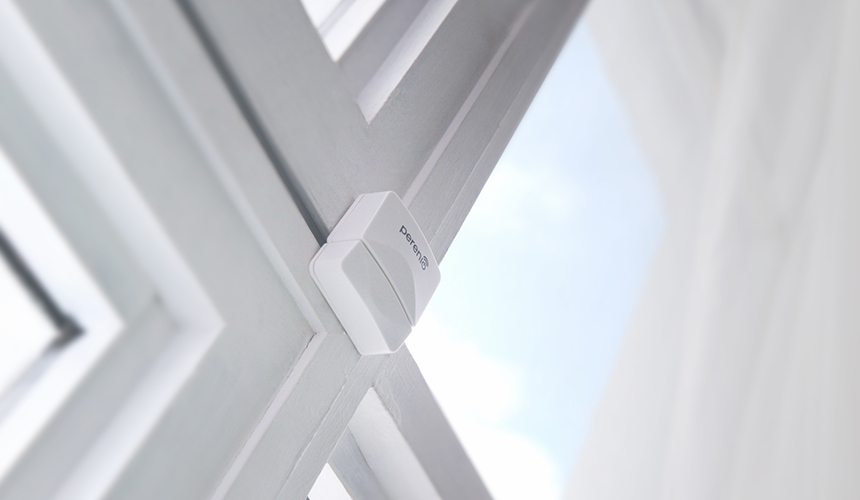What are the differences between Door & Window and Motion Sensors? Why use them both?
The question of what is the need for using both types of sensors often arises in user's heads. From the consumer point of view, one is entirely enough. Let's say, the PECMS01 Motion Sensor. However, Perenio experts recommend using both devices. Read below about the difference between Door & Window and Motion Sensors and how to use them most correctly in the Building Management System.
What is the Door & Window Sensor
The mechanism of this device is simple and has the scientific name “hercon”. It consists of a magnet and a sensor. It is necessary to remove or bring the magnet closer, as the sensor is triggered and transmits a signal to the controller, a device that starts one or several programs. The easiest option is to turn on the siren. However, modern technologies make it possible to diversify the use of a wireless opening sensor.

The sensor can become helpful in solving everyday problems. For example, if you install it on the door of a refrigerator, you can find out if a person ate or not. And placing it on the box with medicines will help to make sure whether the ill person took the medication. It can be used when caring for older adults. The sensor can be placed on the secretary or the door of the bar: this way you will find out if your child behaves good and not trying to have a look into a forbidden place.
Perenio offers its customers a modern PECWS01 Door & Window Sensor. It is compact (45x30x19 mm), easily mounted on the door using duct tape. The battery slowly gets out of work thanks to the ZigBee protocol, so one battery will last for two years. The sensor is also easy to install.
What is a Motion Sensor
Everyone who ever used the subway would run into a Motion Sensor. For example, photovoltaic sensors are installed in the turnstiles. In addition to these tomographic or microwave, sensors exist today. These are the ultrasound devices based on the principle of echolocation. Infrared sensors are most often used in the Building Management Systems since they are more convenient, more compact and most importantly they identify the movement of thermal objects, that is a person to be said in our case.
The infrared Motion Sensors include special sensitive lenses that catch any change in IR radiation. The lenses are visible on the device itself, and it is of them that the cellular surface consists. The more lenses and the more sensitive the elements from which they are made, the better the motion sensor will perform.

Perenio designed the PECMS01 Motion Sensor, which complies with CE, EAS, RoHS, UA.TR standards and is based on PIR technology. This means that it has a passive IR sensor that detects a change in IR radiation. Active sensors themselves generate waves, so they are usually used in more expensive devices or in systems that use other technologies. However, for integrated building management systems, PECMS01 is an utterly sufficient decision. Its coverage is six meters, and it is based on energy efficiency principles. Thus a battery can last up to two years.
Let’s see the differences in motion and presence sensors. The second type is more sensitive and reacts to any movement such as a raised head or a wave of a hand. Therefore, presence sensors are often used to automate climate and light. For example, if there is no one in the room, they can turn off the light automatically. You can enable them only when you activate the code. Such devices usually cost more, so their use in Building Management Systems can be too expensive.
Motion Sensors can be used in security systems or along with devices for climate or lighting automation. Motion Sensors use an alarm and can send an online alert to your smartphone via the Internet. Their work is based on using the infrared radiation, and therefore can be used both during the day and at night. Installing the PECMS01 is easy; you have to find the proper installation point.
Why it is recommended to use both Motion and Door & Window Sensors
Motion and opening sensors are primarily different from the point of the technological principle. IR sensors are more complex than the hercons thus they have numerous weak points. First of all, motion sensors for the front door are more susceptible to interference. Therefore in the most vulnerable places, it is better to replace them with Door & Window Sensors. A simple example: the higher the temperature, the worse the IR sensors work and at a temperature of about 35-37 degrees they are almost entirely useless. Therefore, to install them on windows or in places of direct exposure to sunlight is meaningless. Besides, they are susceptible to radio interference. These shortcomings are typical not only for simple systems, but also for more complex ones, so it does not matter whether you use a passive motion sensor for a staircase or an expensive presence detector.
We recommend our customers to give a thought to the complete solution. If there are many doors in the room, you can use a single motion sensor. But in conjunction with the Door & Window Sensor, you can get more accurate monitoring of break-ins into the room.
Now you know more about the differences between the Door & Window and Motion Sensors, so it will be quite easier to make a choice. In case of any questions, our specialists are always ready to help with specifying more details to recommend you the best options.


















